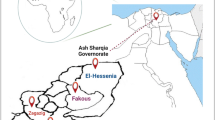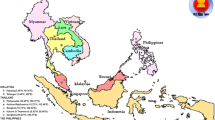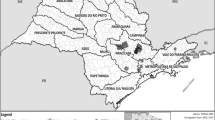Abstract
Cryptosporidium spp. are an emerging pathogen responsible for a large number of diarrhea outbreaks in humans throughout the world. However, the occurrence of epidemic outbreaks caused by this agent in Brazil is poorly known and still needs more attention mainly in the Central-West Region of Brazil, where yet are not studied. Furthermore, there is a need for cheaper or faster methods for detecting Cryptosporidium spp. (given the cost of Envirocheck® filters and IMS kits). Thus, the implementation of standard techniques that enable the identification and quantification of this agent for further study of environmental samples is important. This study aimed at evaluating and comparing immunological techniques for detection of antigen and a real-time PCR for detection and differentiation of Cryptosporidium spp. in samples of treated water. Samples were collected directly from the taps at the entrance of residences and concentrated by a positively charged membrane filter. Oocysts of Cryptosporidium spp. were detected by direct immunofluorescence, ELISA and real-time PCR techniques, and the results were positive in 56.3 % (18/32), 28.1 % (9/32) and 50.0 % (16/32), respectively. The survey results showed for the first time the presence of Cryptosporidium spp. in treated water in the Central-West Region of Brazil. Although real-time PCR showed less positive, it is the one that enables the identification of the species and less expensive when processing a large number of samples. Probably, it would be better to use both techniques, due to their own virtues.


Similar content being viewed by others
References
Ahmed W, Brandes H, Gyawali P, Sidhu JPS, Toze S (2014) Opportunistic pathogens in roof-captured rainwater samples, determined using quantitative PCR. Article Water Res 53:361–369
Adl SM, Simpson AG, Farmer MA, Andersen RA, Anderson OR, Barta JR, Bowser SS, Brugerolle G, Fensome RA, Fredericq S, James TY, Karpov S, Kugrens P, Krug J, Lane CE, Lewis LA, Lodge J, Lynn DH, Mann DG, McCourt RM, Mendoza L, Moestrup O, Mozley-Standridge SE, Nerad TA, Shearer CA, Smirnov AV, Spiegel FW, Taylor MF (2005) The new higher level classification of eukaryotes with emphasis on the taxonomy of protists. J Eukaryot Microbiol 52(5):399–451
Anusz KZ, Mason PH, Riggs MW, Perryman LE (1990) Detection of Cryptosporidium parvum oocysts in bovine feces by monoclonal antibody capture enzyme-linked immunosor assay. J Clin Microbiol 28:2770–2774
Appelbee AJ, Thompson RCA, Olson ME (2005) Giardia and Cryptosporidium in mammalian wildlife—current status and future needs. Trends Parasitol 21:370–376
Araújo RS, Carvalho-Almeida TT, Matté GR, Rojas MVR, Pereira A, Matté MH (2005) Detecção de oocistos de Cryptosporidium spp. em amostras de água salobra. Bol Inst Adolfo Lutz 15:31–32
Araújo AJUS, Gomes AHS, Almeida ME, Kanamura HY (2007) Detecção de Cryptosporidium meleagridis em amostras fecais de pacientes HIV positivos no Brasil. Rev Panam Infectol 9:38–40
Carvalho-Almeida TT, Casimiro AM, Matte GR, Matte MH (2005) Na improved method for extracting Cryptosporidium spp. DNA from preserved faeces and potential application for cryptosporidiosis surveillance. Rev Bras Vig Sanit 1:208–231
Doi Y (2009) Cryptosporidium Pig genotype II in immunocompetent man. Emerg Infect Dis 15(6):982–983
Fahey T (2003) Cryptosporidiosis. Infect Dis Update 10(2):75–80
Feng Y, Ortega Y, Cama V, Terrell J, Xiao L (2008) High intragenotypic diversity of Giardia duodenalis in dairy cattle on three farms. Parasitol Res 103:87–92
Francino O, Altet L, Sanchez-Robert E, Rodriguez A, Solano-Gallego L, Alberola J, Ferrer L, Sanchez A, Roura X (2006) Advantages of real-time PCR assay for diagnosis and monitoring of canine leishmaniosis. Vet Parasitol 137:214–221
Franco, RMB Elayse MH, Maria Ines ZS, Rita Maria LM, Eduardo de CS, Marcela MCC, Romeu CN, Daniel AC, Nilson B, Diego AGL (2012) Avaliação da performance de metodologias de detecção de Cryptosporidium spp. e Giardia spp. em água destinada ao consumo humano, para o atendimento às demandas da Vigilância em Saúde Ambiental no Brasil. Epidemiol. Serv. Saúde [online] 21(2), 233–242. ISSN 1679-4974
Gertler M, Dürr M, Renner P, Poppert S, Askar M, Breidenbach J, Frank C, Preußel K, Schielke A, Werber D, Chalmers R, Robinson G, Feuerpfeil I, Tannich E, Gröger C, Stark K, Wilking H (2015) Outbreak of Cryptosporidium hominis following river flooding in the city of Halle (Saale), Germany, August 2013. BMC Infect Dis 15:88
Gomes AHS, Kanamura HE, Almeida ME, Araújo AJUS (2004) Detecção de Cryptosporidium em amostras fecais por técnica de Nested – PCR e comparação com métodos imunológicos e parasitológicos. Revista Instituto Adolfo Lutz 2(63):255–261
Gonçalves EM, Da Silva AJ, Eduardo MB, Uemura IH, Moura IN, Castilho VL, Corbett CE (2006) Multilocus genotyping of Cryptosporidium hominis associated with diarrhea outbreak in a day care unit in São Paulo. Clinics 61:119–126
Gonzáles-Ruiz A, Bendall R (1985) Size matters: the use of the ocular micrometer in diagnostic parasitology. Parasitol Today 11:83–85
Guy RA, Payment P, Krull UJ, Horgen PA (2003) Real-time PCR for quantification of Giardia and Cryptosporidium in environmental water samples and sewage. Appl Environ Microbiol 69(9):5178–5185
Hashimoto A, Sugimoto H, Morita S, Hirata T (2006) Genotyping of single Cryptosporidium oocysts in sewage by semi-nested PCR and direct sequencing. Water Res 40:2527–2532
Hlavasa MC, Watson JC, Beach MJ (2005) Cryptosporidiosis surveillance—United States 1999–2002. MMWR Surveill Summ 54:1–8
Huber F, Da Silva S, Bomfim TC, Teixeira KR, Bello AR (2007) Genotypic characterization and phylogenetic analysis of Cryptosporidium spp. from domestic animals in Brazil. Vet Parasitol 150:65–74
Huck PM, Coffey BM, Emelko MB, Maurizio DD (2002) Effects of filter operation on Cryptosporidium removal. J Am Water Works Assoc 94(6):97–111
Jex AR, Smith HV, Monis PT, Campbell BE, Gasser RB (2008) Cryptosporidium—biotechnological advances in the detection, diagnosis and analysis of genetic variation. Biotechnol Adv 26:304–317
Jothikumar N, Silva AJ, Moura I, Qvarnstrom Y, Hill VR (2008) Detection and differentiation of Cryptosporidium hominis and Cryptosporidium parvum by dual TaqMan assays. J Med Microbiol 57:1099–1105
Karanis P, Kourenti C, Smith H (2007) Waterborne transmission of protozoan parasites: a world wide review of outbreaks and lessons learnt. J Wat Health 5:1–38
Keshavarz A, Haghighi A, Athari A, Kazemi B, Abadi A, Mojarad EN (2009) Prevalence and molecular characterization of bovine Cryptosporidium in Qazvin province, Iran. Vet Parasitol 160(3–4):316–318
King B, Fanok S, Phillips R, Swaffer B, Monis P (2015) Integrated Cryptosporidium assay to determine oocyst density, infectivity, and genotype for risk assessment of source and reuse water. Appl Environ Microbiol 81:3471–3481. doi:10.1128/AEM.00163-15
Lake IR, Nichols G, Bentham G, Harrison FC, Hunter PR, Kovats SR (2007) Cryptosporidiosis decline after regulation, England and Wales, 1989–2005. Emerg Infect Dis 13:623–625
Le Chevallier MW, Norton WD (1992) Examining relationships between particle counts and Giardia, Cryptosporidium and turbidity. J Am Water Works Assoc 84(12):54–60
Mackenzie WR, Hoxie NJ, Proctor ME, Gradus MS, Blaie KA, Peterson DE, Kazmierrczak JJ, Addiss DG, Fox KR, Rose JB, Davis JP (1994) A massive outbreak in Milwaukee of Cryptosporidium infection transmitted through the public water supply. New Engl J Med Boston 3:161–167
Mark AG, John B (1994) Incidence of respiratory cryptosporidiosis in Georgia Broilers: 1987–92. Avian Dis 38(2):358–360
Meireles MV, Soares RM, Dos Santos MM, Gennari SM (2006) Biological studies and molecular characterization of a Cryptosporidium isolate from ostriches (Struthio camelus). J Parasitol 92:623–626
Monis PT, Giglio S, Keegan AR, Andrew Thompson RC (2005) Emerging technologies for the detection and genetic characterization of protozoan parasites. Trends Parasitol 21:340–346
Morgan UM, Thompson RCA (1998) PCR detection of Cryptosporidium, the way forward? Parasitol Today 14:241–245
Palmateer G, Manz D, Jurkovic A, Mclnnis R, Unger S, Kwan KK, Dutka BJ (1999) Toxicant and parasite challenge of manz intermittent slow sand filter. Environ Toxicol 14:217–225
Pereira JT, Costa A, Silva MBO, Schuchard W, Osaki SC, Castro EA, Paulino RC, Thomaz-Soccol V (2008) Comparing the efficacy of chlorine, chlorine dioxide, and ozone in the inactivation of Cryptosporidium parvum in water from Paraná State, Southern Brazil. Appl Biochem Biotechnol 151:464–473
Pilai DR (2009) Cryptosporidium spp. Rabbit genotype, a newly identified human pathogen. Emerg Infect Dis 15(5):829–830
Plutzer J, Karanis P (2009) Genetic polymorphism in Cryptosporidium: an update. Vet Parasitol 165:187–199
Rodgers MR, Flanigan DJ, Jakubowsk W (1995) Identification of algae which interfere with the detection of Giardia cysts and Cryptosporidium oocysts and a method for alleviating this interference. Appl Environ Microbiol 61(10):3759–3763
Santos SFO, Silva HD, Souza-Junior ES, Anunciação CE, Silveira-Lacerda EP, Vilanova-Costa CAST, Garcia-Zapata MTA (2010) Environmental monitoring of opportunistic protozoa in rivers and lakes in the neotropics based on yearly monitoring. Water Quality Exposure Health 2:1–8
Silva HD, Wosnjuk LAC, Santos SFO, Vilanova-Costa CAST, Pereira FC, Silveira-Lacerda EP, García zapata MTA, Anunciação CE (2010) Molecular detection of adenoviruses in lakes and Rivers of Goiânia, Goiás, Brazil. Food Environ Virol 2:35–40
Soba B, Petrovec M, Mioc V, Logar J (2006) Molecular characterization of Cryptosporidium isolates from humans in Slovenia. Clin Microbiol Infect 12:918–921
Soldan OCP, Vasquez FV, Varas G, Cordo GP, Soto JRV, Sanches-Moreno M, Gonzales IR, Lombardo MJR (2006) Intestinal parasitism in Peruvian children and molecular characterization of Cryptosporidium species. Parasitol Res 98:576–581
Souza SL, Gennari SM, Richtzenhain LJ, Pena HF, Funada R, Cortez A, Gregori F, Soares RM (2007) Molecular identification of Giardia duodenalis isolates from humans, dogs, cats and cattle from the state of São Paulo, Brazil, by sequence analysis of fragments of glutamate dehydrogenase (GDH) coding gene. Vet Parasitol 149:258–264
Stancari RCA (2013) Determinação da sensibilidade do teste de ELISA para pesquisa de Cryptosporidium spp. e Giardia spp. em amostras de águas brutas. Rev Inst Adolfo Lutz. São Paulo 72(3):234–238
Sunderlanda D, Graczyk TK, Tamanga L, Breyssea PN (2007) Impact of bathers on levels of Cryptosporidium parvum oocysts and Giardia lamblia cysts in recreational beach waters. Water Res 41:3483–3489
Thomaz A, Meireles MV, Soares RM, Pena HF, Gennari SM (2007) Molecular identification of Cryptosporidium spp. from fecal samples of felines, canines and bovines in the state of São Paulo, Brazil. Vet Parasitol 150:291–296
Trotz-Williams LA, Martin DS, Gatei W, Cama V, Peregrine AS, Martin SW, Nydam DV, Jamieson F, Xiao L (2006) Genotype and subtype analyses of Cryptosporidium isolates from dairy calves and humans in Ontario. Parasitol Res 99:346–352
Tyzzer EE (1907) A sporozoan found in the peptic glands of the common mouse. Proc Soc Exp Biol Med 5:12–13
Tyzzer EE (1912) Cryptosporidium parvum (sp. nov.), a coccidium found in the small intestine of the common mouse. Arch Protistenkd 26:394–412
Tzipori S, Griffiths JK (1998) Natural history and biology of Cryptosporidium parvum. Adv Parasitol 40:5–36
Tzipori S, Ward H (2002) Cryptosporidiosis: biology, pathogenesis and disease. Microbes Infect 4:1047–1058
Ungar B (1990) Enzyme-linked immunoassay for detection of Cryptosporidium antigens in fecal specimens. J Clin Micro 28(11):2491–2495
Volotão AC, Costa-Macedo LM, Haddad FS, Brandão A, Peralta JM, Fernandes O (2007) Genotyping of Giardia duodenalis from human and animal samples from Brazil using beta-giardin gene: a phylogenetic analysis. Acta Trop 102:10–19
Xiao L (2010) Molecular epidemiology of cryptosporidiosis: an update. Exp Parasitol 124:80–89
Xiao L, Feng Y (2008) Zoonotic cryptosporidiosis. FEMS Immunol Med Microbiol 52:309–323
Xiao L, Sulaiman I, Fayer R, Lal AA (1998) Species and strain-specific typing of Cryptosporidium parasites in clinical and environmental samples. Memórias do Instituto Oswaldo Cruz 93(5):687–692
Xiao L, Morgan UM, Limor J, Escalante A, Arrowood M, Shulaw W, Thompson RC, Fayer R, Lal AA (1999) Genetic diversity within Cryptosporidium parvum and related Cryptosporidium species. Appl Environ Microbiol 65:3386–3391
Xiao L, Singh A, Limor J, Graczyk TK, Gradus S, Lal A (2001) Molecular characterization of Cryptosporidium oocysts in samples of raw surface water and wastewater. Appl Environ Microbiol 67(3):1097–1101
Author information
Authors and Affiliations
Corresponding author
Rights and permissions
About this article
Cite this article
Santos, S.F.O., Silva, H.D., Wosnjuk, L.A.C. et al. Occurrence and Evaluation of Methodologies to Detect Cryptosporidium spp. in Treated Water in the Central-West Region of Brazil. Expo Health 8, 117–123 (2016). https://doi.org/10.1007/s12403-015-0187-1
Received:
Revised:
Accepted:
Published:
Issue Date:
DOI: https://doi.org/10.1007/s12403-015-0187-1




